Vietnam’s coastline stretches more than 3000 kilometers north to south, a long thin country with mountain ranges running down its central spine. The ocean forms the entire eastern border of Vietnam, so beaches and islands are scattered through every region and climate zone.
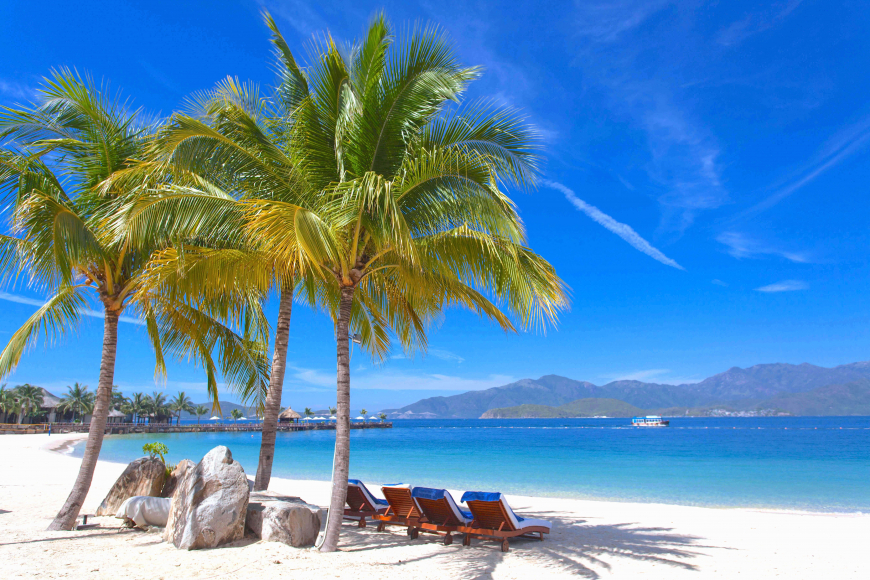
The diversity of the country extends to its beaches. There are beaches in buzzing cityscapes backed by shining skyscrapers and nightclubs, like in Da Nang and Nha Trang. There’s traditional fishing villages where time seems to stop and rural life passes by relatively untouched by globalization or urbanization. Secluded and untrampled beaches burst from the arms of the jungle.
The beaches in Vietnam are truly uncountable, and many of the best-known are landbound along the shoreline. For a real adventure, head out into the open ocean towards an island. Here are some of the top five beach islands in Vietnam, each a world of its own.
Top Five Beach Islands in Vietnam
Phu Quoc Island
Called the “Pearl Island” for its dazzling white sand beaches, more than half of the island and its surrounding ocean is a protected biosphere reserve. The 10,000 hectares of the Phu Quoc National Park’s landmass are home to nearly a thousand plant species, many of which are endangered, and the marine biosphere teems with hundreds of species of coral reef, tropical fish, and other aquatic species.
Despite its underwater allure, Phu Quoc’s main attraction is its coastline, with beaches garlanding the island from north to south. Long Beach is the most popular, with plenty of hospitality options available to upgrade uninterrupted sunset views. On the southern side of the island, Khem Beach and Sao beach offer peace and quiet for those who prefer to lounge in more secluded nature.
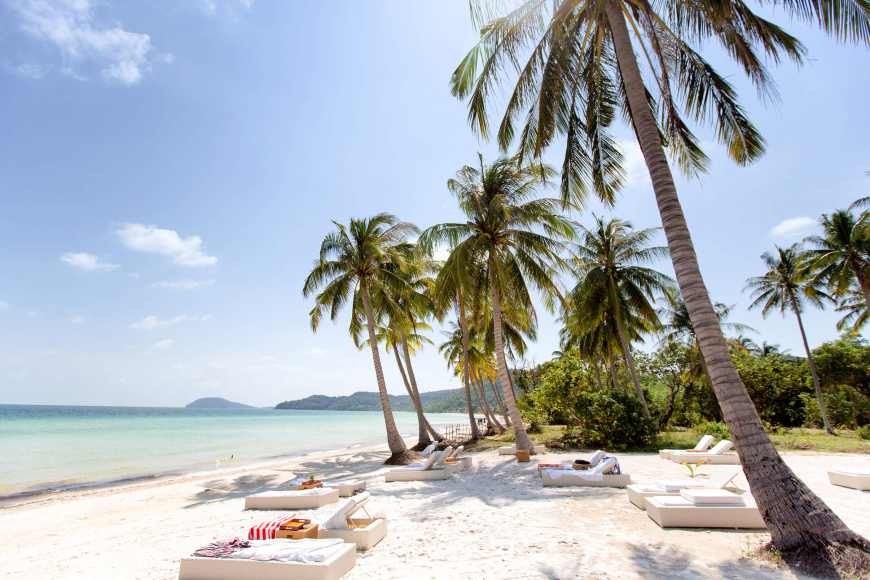
Cat Ba Island, Hai Phong
Cat Ba Island is the largest island of an archipelago in Ha Long Bay, the world-famous oceanic landscape where limestone karsts topped with wild jungle burst from emerald green water. Just a few of these outcroppings are inhabitable, and the largest of them is Cat Ba Island. Much like Phu Quoc, nearly half of Cat Ba Island is a protected National Park home to mangrove forests, coral reefs, and a range of plant and animal species.
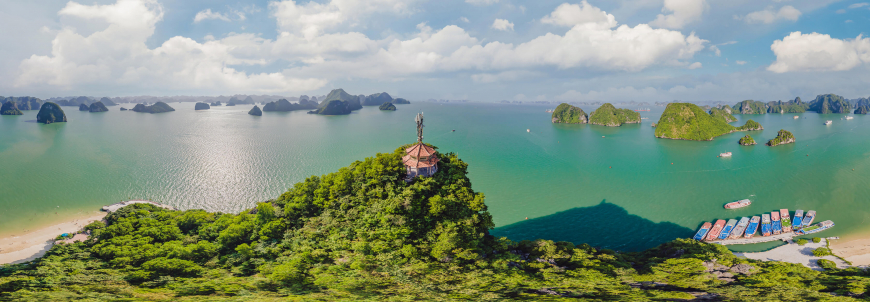
The coastline is mostly rocky cliffs with viewpoints over the ocean and across the island’s forests, but there are several accessible sand beaches. Trekking trails meander through the park’s six different ecosystems, up to the top of waterfalls in tropical rainforests and down to tidal flats and mangrove forests. The three main beaches, Cat Co 1, 2, and 3, are all yellow sand beaches situated close to Cat Ba Town, an outburst of development sitting on the shore of Lan Ha Bay with hotels, resorts, and restaurants to accommodate every kind of traveler.
Cham Islands, Quang Nam Province
The Cham Islands are an archipelago of 8 small islands just off the coast of Hoi An, originally settled by Cham people about 3,000 years ago. Like Hoi An itself, the Cham Islands draw visitors for their unique combination of culture, history, nature, and aesthetic.
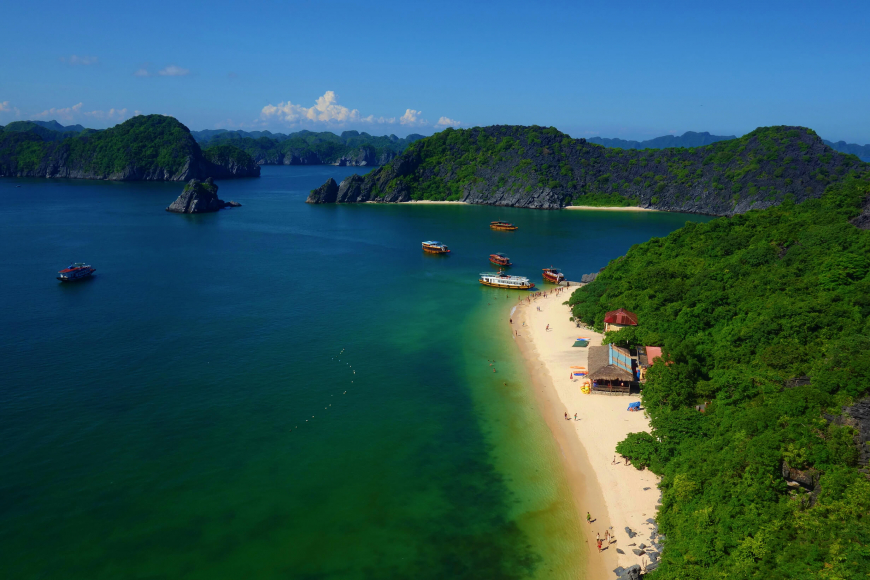
These islands are named for the Cham people, the inhabitants of the Champa Kingdom that stretched through Central Vietnam from the 2nd until the 19th century. The Hindu temples on the Cham Islands are some of the best places to explore the legacy of the Champa Kingdom. Hon Lao–the only inhabited island in the archipelago–is still populated by the Cham people, who are one of the 54 minority ethnic groups of modern Vietnam.
Bai Lang is the largest town on Hon Lao and the access point to the Cham Islands, and it can get busy with tourists during the daytime. Head to Bai Huong, a fishing village just southeast of the main port, for some true peace and quiet.
Con Son Island, Con Dao Archipelago
Con Son is part of a 15-island archipelago called the Con Dao Islands. The Con Dao Archipelago boasts a collective total of 200 kilometers of coastline, far enough from mainland Vietnam that it has avoided the pollution and damage that comes with excessive tourism and human interference. As a result, the beaches, jungles, and surrounding coral reefs have remained healthy and lush.
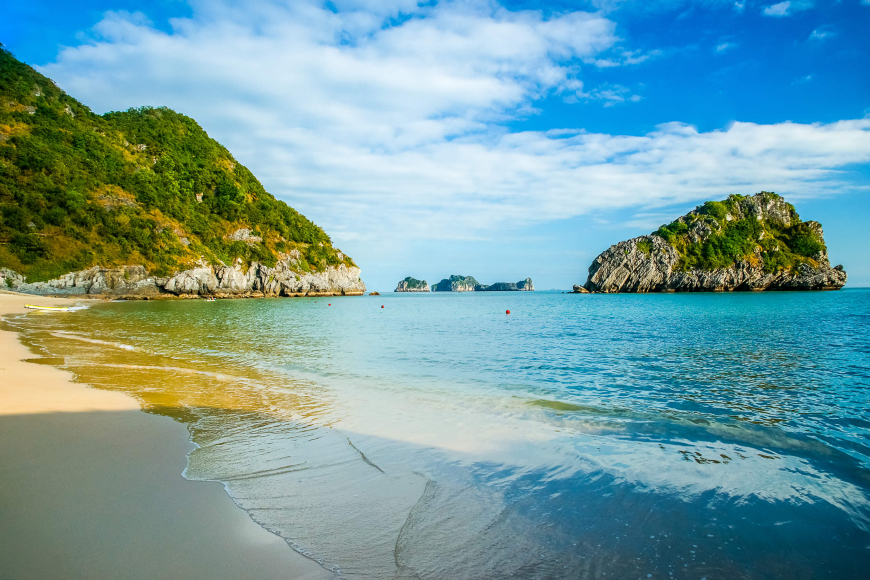
Once famous for brutal French prisons incarcerating Vietnamese political prisoners, Con Son Island is now known for spectacular beaches, old-growth forests, and wild natural landscapes. Cheap local homestays, mid-range hotels, and luxury resorts can all be found in Con Son Town, which is a good base for exploration.
The whole archipelago is teeming with beaches, including one that only emerges once a day at low tide. But some of the best are actually on Con Son: Lo Voi Beach offers tranquility, and Dat Doc Beach provides a truly secluded escape. Dam Trau Beach is hemmed in by cliff sides and forests, while baby green sea turtles are released in droves on Bay Canh Island once a year.
Ly Son Island
Ly Son is starkly different from the other beach islands on this list. Ly Son is a volcanic island, formed of five different extinct volcanic craters. The tops of these craters sink in sheer black drops down to the ocean, marking the path that glowing red magma once took sliding down to the waves below.
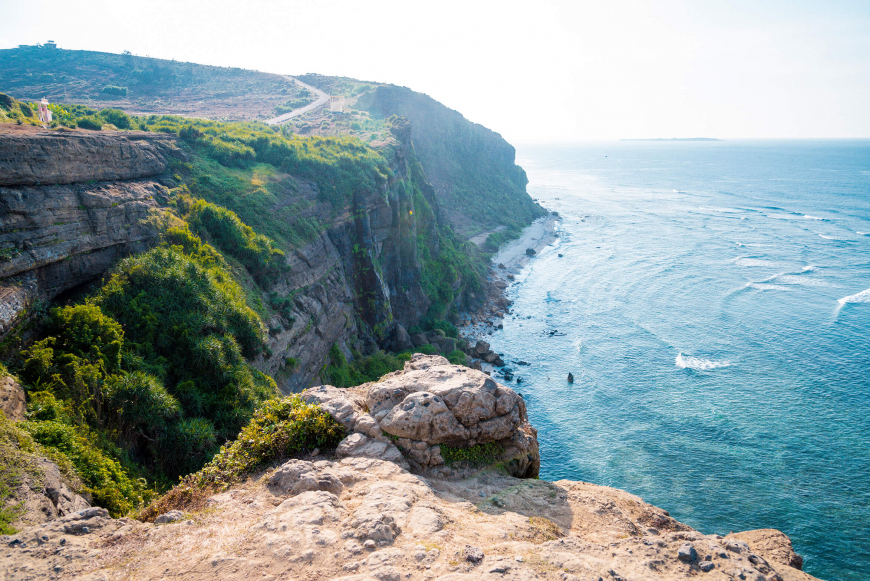
Hike or drive up the craters for views of strange rock formations across a patchwork quilt of flat agricultural land. Make no mistake, there are beaches here, with some of the cleanest and clearest turquoise water in the country. The coves of soft sand all but glow against the sharp, dark cliff sides behind them. Waves crash dramatically against coal-black and jagged rocky outcroppings, shaking the island itself.
Outside of the other-worldly geology, Ly Son Island also hosts more than 50 temples and shrines as well as an extensive agricultural industry. The island is nationally famous for its garlic fields, which grow brilliantly in the rich volcanic soil and can be smelled from kilometers away.
What to Do on Vietnam’s Top 5 Beach Islands
All five of these islands offer a variety of activities that can offer either intimate encounters with wildlife and natural landscapes, full-tilt adrenaline-packed adventures, or cultural education through historical landmarks.
Motorbike Exploration
Renting a motorbike is a great way for independent explorers to get acquainted with the terrain, and many of the national parks and nature reserves have well-paved roads winding through them. Head to the top of a mountain in Cat Ba, Phu Quoc, or Ly Son for breathtaking views of sky, sea, and mountain peaks.
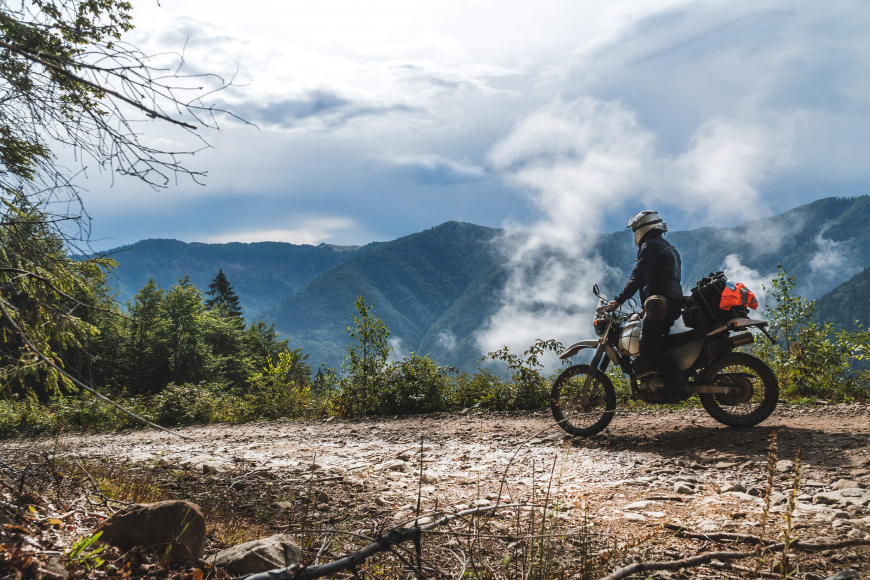
Drive freely between cultural attractions, visiting secluded beaches in the morning, temples and pagodas in the afternoons, and fishing villages for seafood dinners in the evening.
Cultural Immersion
These five islands may be popular for beach vacations but they are also home to important cultural landmarks, each very different from the next.
Phu Quoc is world-famous for its fish sauce, and it’s possible to visit a fish sauce distillery to learn how the island’s number one export product is made. Fish sauce is one of the most important ingredients in Vietnamese cuisine, so an in-depth educational foray into its makings is a great way to get closer to the culture. Like Phu Quoc, the garlic fields of Ly Son offer an agricultural access point into the island’s culture.
Tour the relics of the Champa Kingdom in the Cham Islands for a window into the powerful and seafaring Hindu culture that ruled over much of what we now know as central and southern Vietnam for centuries. The Cham people were masterful artisans and architects whose stone temples have survived - though only in ruins - for hundreds and thousands of years, through war and bombings and the transitions of dynasties.
While the Cham Islands offer a taste of ancient past, Con Son Island offers visitors a somber education of tragedies in more recent history. Con Son Prison is now a museum that preserves important information about the true horrors of war and colonialism. It’s a critical place to visit for anyone interested in Vietnamese politics and history over the last century.
Island Hopping
Cat Ba, Phu Quoc, Con Son, and the Cham Islands are all situated in archipelagoes, so why not spend a day island-hopping between them? The Northern, Southern, and Central regions of Vietnam each have different climate zones, each home to different histories, cultures, and plant and animal species. Travelers who are lucky enough to visit all five of these islands can compare the different flora and fauna that live in different ecosystems.
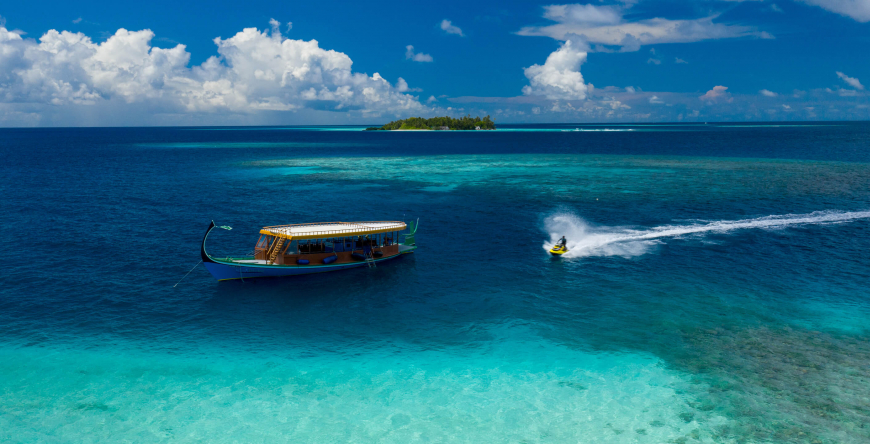
Water Sports
All five of these islands are popular for snorkeling, while Con Dao and Phu Quoc are two of the best scuba diving destinations in the country. There are about two dozen dive sites of varying difficulties around the Con Dao archipelago, along with the only shipwreck in Vietnam that’s possible to dive to. The Cham Islands are popular dive sites for beginners, due to their accessible caves and shallow depths.
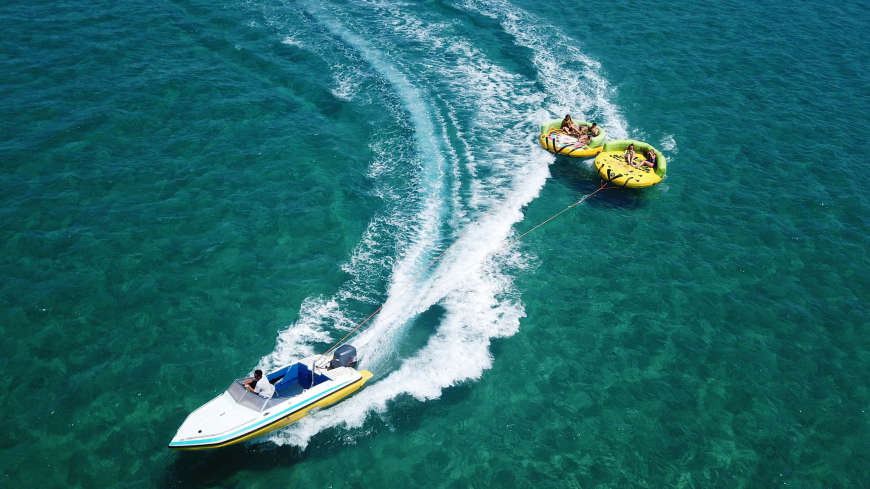
Phu Quoc is the most popular destination in Vietnam for water sports of all kinds, including jet skiing, parasailing, windsurfing, and kite surfing. Kayaking is available in Phu Quoc, but Cat Ba Island is the best destination for it. Hop in a kayak to explore the myriad limestone islands bursting from Ha Long Bay, each one a new world.
Visiting Beach Islands in Vietnam Safely
A fun trip is a safe one, and following a few simple precautions can prevent illness and accidents. Vietnam is actually an extremely safe country for travelers. The COVID epidemic has been very well controlled, and social dangers like violence or theft are rare. Still, it’s always better to be prepared.
Download the “Safe Vietnam Tourism” app to find out about the epidemic situation in different destinations and access information about tourism services that have been registered as meeting safety standards.
Be sure to buy travel insurance. This has always been a wise travel preparation, made only more important during the epidemic. Travel insurance will cover valuables in case of theft and medical bills in case of accident, injury, or illness – including COVID-19.
The COVID-19 epidemic prevention regulations here are simple and clear. The Ministry of Health enforces the “5Ks” of COVID. Translated into English, these are as follows: wear a mask, disinfect, social distance, do not gather, fill out a medical declaration. Following these five steps is an easy way to stay safe and healthy and enjoy a trip to Vietnam from beginning to end.




